
Introduction
- India is one of the most vulnerable regions despite having contributed only about 4 per cent in the cumulative global emissions (for the period 1850-2019) and maintaining its per capita emission at far less than the world average.
- World average per capita GHG emissions – 6.3 tCO2e in 2020.
- India remains far below the world average at 2.4 tCO2e.
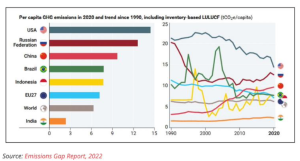
Net Zero Pledges
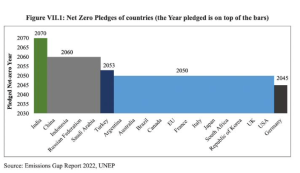
Progress on India’s Climate Action
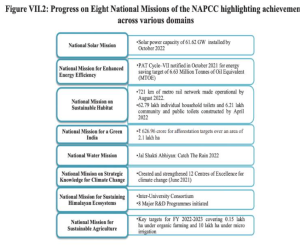
National Adaptation Fund for Climate Change
- National Adaptation Fund for Climate Change (NAFCC), a central sector scheme, was initiated in 2015-16 to support adaptation activities in the States and Union Territories (UTs) of India that are vulnerable to the adverse effects of climate change.
- NAFCC is implemented in project mode.
Updated NDCs
- Demonstrating higher ambition in its climate action, the Government of India submitted its updated NDC on August 26, 2022.
- The new NDC with enhanced targets translates the vision of the “Panchamrit” at the UNFCCC Conference of Parties (COP 26) in Glasgow in November 2021
- To reduce the Emissions Intensity of its GDP by 45 per cent by 2030, from the 2005 level.
- To achieve about 50 per cent cumulative electric power installed capacity from non-fossil fuel-based energy resources by 2030, with the help of the transfer of technology and low-cost international finance, including from the Green Climate Fund (GCF).
- To create an additional carbon sink of 2.5 to 3 billion tonnes of CO2 equivalent through additional forest and tree cover by 2030.
Status of Forest and Tree Cover
- The country ranks third globally with respect to the net gain in average annual forest area between 2010 and 2020.
- Schemes like the Green India Mission (GIM), Compensatory Afforestation Fund Management and Planning Authority (CAMPA), National Afforestation Programme (NAP), Green Highway Policy – 2015, Policy for enhancement of Urban Greens, National Agro-forestry Policy, and Sub-Mission on Agro-forestry (SMAF), etc. are among the most important ones.
Carbon Stock in India’s Forest and Tree Cover
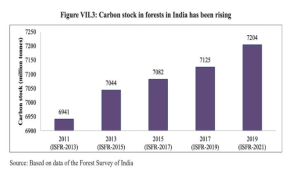
- Among the Indian States, Arunachal Pradesh has the maximum carbon stock in forests (1023.84 million tonnes), followed by Madhya Pradesh (609.25 million tonnes).
- The per-hectare forest carbon stock among different States/UTs indicates that Jammu & Kashmir is contributing the maximum per-hectare carbon stock of 173.41 tonnes, followed by Himachal Pradesh (167.0 tonnes), Sikkim (166.2 tonnes) and Andaman & Nicobar Islands (162.9 tonnes).
Preservation of Ecosystems
- Ramsar sites: India has 75 Ramsar sites covering an area of 13.3 lakh ha, and 49 of these have been added in the last 8 years.
- Mangrove cover: The mangrove cover in the country has increased by 364 sq. km. in 2021 as compared to 2013.
- The Government has taken both regulatory and promotional measures to protect and conserve mangroves.
- The National Coastal Mission Programme on ‘Conservation and Management of Mangroves and Coral Reefs’ is being implemented.
- Regulatory measures are implemented through Coastal Regulation Zone (CRZ) Notification (2019) under the Environment (Protection) Act, 1986; the Wild Life (Protection) Act, 1972; the Indian Forest Act, 1927.
- River Conservation and Rejuvenation – The Government is working on mapping and converging the 5Ps’ – People, Policy, Plan, Programme and Project.
- It has been supplementing the efforts of the States/Union Territories (UTs) by providing financial and technical assistance for the abatement of pollution in identified polluted stretches of rivers in the country through the Central Sector Scheme of Namami Gange for River Ganga and its tributaries, and the Centrally Sponsored Scheme of National River Conservation Plan (NRCP) for other rivers.
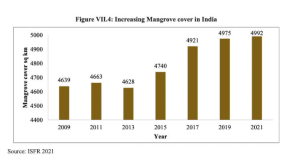
Approach to Transition to Renewable Energy Sources
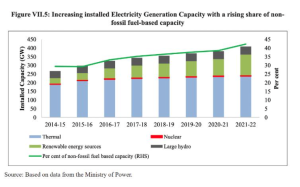
- While the target was to achieve 40 per cent of the installed electric capacity from nonfossil fuel sources by 2030 in the initial NDC submitted in 2015, the target has already been achieved.
- India is now striving to achieve the target of 50 per cent cumulative electric power installed capacity from non-fossil fuel-based energy resources by 2030, in line with updated NDCs.
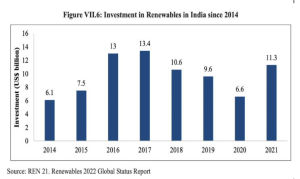
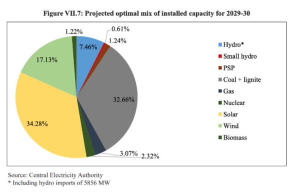
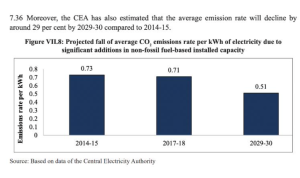
Green Hydrogen
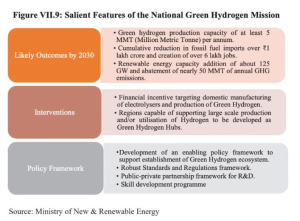
Levelised Cost of Hydrogen
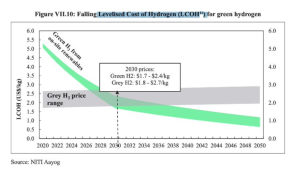
- The Levelised Cost of Hydrogen (LCOH) is a variable that indicates how much it costs to produce 1 kg of Green Hydrogen, taking into account the estimated costs of the investment required and the cost of operating the assets involved in its production.
Rare Earth Elements (REE) and Critical Minerals (CM)
- Cobalt, copper, lithium, nickel, and rare earth elements (REEs) are critical for producing electric vehicles and batteries and harnessing solar power and wind energy.
- A typical electric car requires six times the mineral inputs of a conventional car, and an onshore wind plant requires nine times more mineral resources than a gas-fired plant.
- Lithium, nickel, cobalt, manganese and graphite are crucial to battery performance, longevity and energy density.
- REEs are essential for permanent magnets that are vital for wind turbines and EV motors.

- Electricity networks need a huge amount of copper and aluminium, with copper being a cornerstone for all electricity-related technologies.
- In order to ensure the mineral security of the nation and to attain self-reliance in the area of critical and strategic minerals, the Ministry of Mines has created a Joint Venture company, namely Khanij Bidesh India Ltd (KABIL).
- KABIL is mandated to identify and acquire overseas mineral assets of critical and strategic nature, such as Lithium, Cobalt etc.
- Further, the Ministry of Mines, Government of India and the Department of Industry, Science, Energy and Resources (DISER), Government of Australia, signed an MoU on June 3, 2020 for cooperation in the field of mining and processing of critical and strategic minerals.
Long-Term Low Emissions Development Strategy (LT-LEDS)
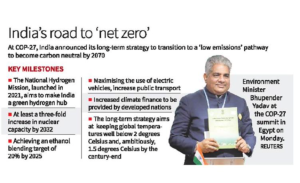
Finance for Sustainable Development
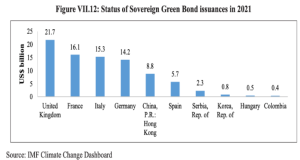
- Green bonds are financial instruments that generate proceeds for investment in environmentally sustainable and climate-suitable projects.
- In keeping with the ambition to reduce the carbon intensity of the economy significantly, the Union Budget 2022-23 announced the issue of Sovereign Green Bonds.
- The Framework has been designed to comply with the components and key recommendations of the International Capital Market Association (ICMA) Green Bond Principles (2021).
- Over time, the SGrBs would provide a pricing reference for private sector entities in India for their domestic borrowings through Environment, Social, and Governance (ESG) bonds.
Regulatory Framework for Issuance of Green Debt Securities
- SEBI introduced the regulatory framework for issuance of green debt securities as a mode of sustainable finance under the erstwhile SEBI (Issue and Listing of Debt Securities) Regulations, 2008, (ILDS Regulations), vide circular dated May 30, 2017.
- It has been decided in the SEBI board meeting dated December 20, 2022, to:
- a. Enhance the scope of the definition of green debt security by including new modes of sustainable finance in relation to pollution prevention and control, eco-efficient products, etc.; 234 Economic Survey 2022-23
- b. Introduce the concept of blue bonds (related to water management and marine sector), yellow bonds (related to solar energy) and transition bonds as subcategories of green debt securities.
Investing in Resilience for Sustainable Development
- SEBI has been one of the early adopters of sustainability reporting for listed entities and requires mandatory ESG-related disclosures for the top 100 listed entities (by market capitalisation) since 2012.
- Over the years, the requirement was strengthened to cover the top 500 and then the top 1000 entities.
- SEBI has issued new sustainability reporting requirements under the Business Responsibility and Sustainability Report (BRSR), which are more granular with quantifiable metrics in line with the principles ensconced in the ‘National Guidelines on Responsible Business Conduct’.
- The BRSR was made mandatory for the top 1000 listed entities (by market capitalisation) from 2022–23.
COP 27
- The COP 27 to the UNFCCC was held from 6 to 20 November 2022 in Sharm el-Sheikh, Egypt.
- India participated in COP 27, with a focus on mainstreaming the theme of LiFE – Lifestyle for Environment.
- The cover decision of COP 27, titled the Sharm el-Sheikh Implementation Plan, notes the ‘importance of the transition to sustainable lifestyles and sustainable patterns of consumption and production for efforts to address climate change’
India’s Initiatives at the International Stage
- The International Solar Alliance (ISA) is a treaty-based inter-governmental organisation working to create a global market system to tap the benefits of solar power and promote clean energy applications.
- ISA’s mission is to unlock US$ 1 trillion of investments in solar by 2030 while reducing the cost of the technology and its financing.
- With the signing and ratification of the ISA Framework Agreement by 15 countries on 6 December 2017, ISA became the first international intergovernmental organisation to be headquartered in India.
- The CDRI was launched by India during the United Nations Climate Action Summit on 23 September 2019 in New York.
- It is a global partnership of National Governments, UN agencies and programmes, multilateral development banks and financing mechanisms, the private sector, and academic and knowledge institutions.
- It aims to promote the resilience of infrastructure systems to climate and disaster risks, thereby ensuring sustainable development.
- The LeadIT gathers countries and companies that are committed to action to achieve the Paris Agreement.
- It was launched by the governments of Sweden and India at the UN Climate Action Summit in September 2019 and is supported by the World Economic Forum.
- LeadIT members subscribe to the notion that energy-intensive industries can and must progress on lowcarbon pathways, aiming to achieve net-zero carbon emissions.
Initiatives Related to other Environmental Issues
- Ensuring the Conservation of Biodiversity –
- May 22nd is celebrated as an International Day for Biological Diversity every year globally to create awareness among the citizens and stakeholders on the importance and need for the conservation of biological diversity.
- India ranks eighth in the world and fourth in Asia among the mega-diverse countries in the world.
- In conformity with the spirit of the CBD, India enacted the Biological Diversity Act in 2002.
- India and Nepal signed a Memorandum of Understanding (MoU) in A.ugust 2022 on biodiversity conservation
Wildlife – Its Preservation and Protection
- A comprehensive legislation was enacted in 1972 called the Wildlife (Protection) Act 1972 to provide special legal protection to our wildlife and the endangered species of fauna.
- As of 10 August 2022, India is home to 53 Tiger Reserves covering approximately 75,796.8 sq. km area in 18 States, with about 75 per cent of the wild tiger population at the global level.
- India achieved the goal of doubling the tiger numbers in 2018, four years before the targeted year 2022.
- In addition, 17 Tiger Reserves in the country have CA|TS international accreditation, and two have received International Tx2 Award.
- Similarly, the population of Asiatic Lions has shown a steady increase, with a population of 674 individuals (2020), 28.87 per cent (one of the highest growth rates so far) higher than the 523 lions in 2015.
- India now (2020) has 12,852 leopards compared to the previous estimate of 7910 conducted in 2014. More than a 60 per cent increase in population has been recorded.
- The current population estimates indicate about 50,000 – 60,000 Asian elephants worldwide.
- More than 60 per cent of the population is in India.
- Indian Elephant has also been listed in Appendix I of the Convention of the Migratory species.
Wild Life (Protection) Act 1972 – Amendment
- The Wild Life (Protection) Act 1972 has six schedules. The Act aims to rationalise the schedules by
- reducing the number of schedules for specially protected animals to two,
- removing the schedule for vermin species, and
- inserting a new schedule for specimens listed in the Appendices under CITES (scheduled specimens).
Waste Management
- As an attempt to reduce pollution caused due to littered plastic waste in the country, the Ministry of Environment, Forest and Climate Change, Government of India, notified the Plastic Waste Management Amendment Rules, 2021, on August 12, 2021.
- On July 1, 2022, a ban was imposed on the manufacture, import, stocking, distribution, sale and use of identified single-use plastic items, which have low utility and high littering potential, all across the country.
- The fifth United Nations Environment Assembly held in Nairobi adopted a resolution “End plastic pollution: towards an international legally”
- The Government published the Battery Waste Management Rules, 2022, on August 24, 2022 to ensure environmentally sound management of waste batteries.
- New rules will replace Batteries (Management and Handling) Rules, 2001.
- The rules cover all types of batteries, viz. Electric Vehicle batteries, portable batteries, automotive batteries, and industrial batteries.
- The rules function based on the concept of Extended Producer Responsibility (EPR).
- The Government notified the E-Waste (Management) Rules, 2022, on November 2, 2022.
- These rules will replace the E-waste (Management) Rules, 2016, and will be effective from April 1, 2023.
- These rules will launch a new Extended Producer Responsibility (EPR) regime for e-waste recycling.
➡️UPSC 2023 General Studies Course: https://sleepyclasses.com/general-studies-for-upsc/
➡️Sociology Optional for UPSC : https://sleepyclasses.com/sociology-for-upsc/
➡️Political Science and IR for UPSC: https://sleepyclasses.com/psir-for-upsc/
➡️Signup here – https://sleepyclasses.com/
Have any query related to UPSC preparation: 📞Contact Us ► Toll-Free: 1800 890 3043 ► Mobile: 6280133177 ► Email: Sleepy.Classes@gmail.com ► WhatsApp: 6280133177



